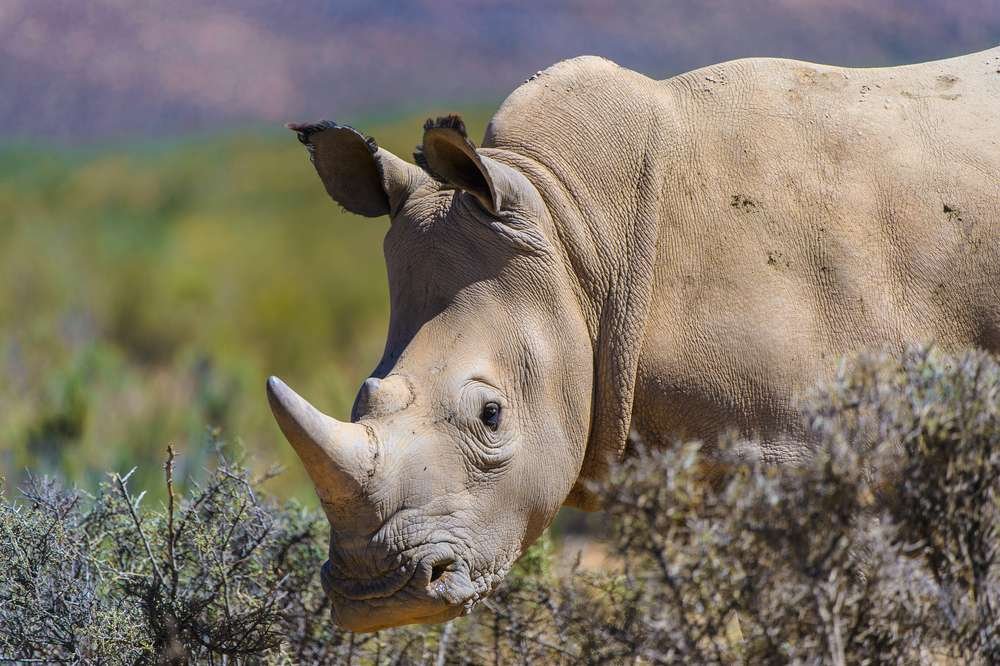Southern White Rhino
( chipembele, sukulu, southern white rhinoceros or square-lipped rhinoceros )
- Ceratotherium simum simum
- IUCN Status: Near Threatened
- Trend: decreasing

- Kingdom: Animalia
- Phylum: Chordata
- Class: Mammalia
- Order: Perissodactyla
- Family: Rhinocerotidae
- Genus: Ceratotherium
Share:
General Information
The southern white rhinoceros is one of largest and heaviest land animals in the world. Zambia is home to two African species – the Black Rhino (Diceros bicornis minor) which live in woodland areas and the Southern White Rhino (Ceratotherium simum simum) which prefer more open grassland habitats. The name rhinoceros comes from the Greek meaning ‘nose horn’ and they are called rhinos for short. A group of rhinos is called a ‘crash’.
Fun Facts!
White Rhinos are the second largest land mammals in the world. They are the most sociable of all the rhino species and live in herds or crashes. An adult rhino can munch on up to 680 kilograms of plants a day. White rhinos have surprisingly good hearing and even better sense of smell! They can sniff out waterholes from miles away, a handy skill in the dry savanna.
Despite their bulky bodies, they can run surprisingly fast, reaching speeds of up to 48 kilometers per hour in short bursts. Imagine a charging rhino – definitely not something you want to outrun. Their impressive horns aren’t made of bone, but rather keratin, the same stuff as our hair and nails.
Description
- Shoulder height: 1.5 – 1.8 metres
- Length: 3 – 3.75 metres
- Weight: 900 – 2,500 kgs
- Lifespan: up to 50 years old
Ecology and Behaviour
White rhinos are the most sociable of all the species, with six or more individuals associating together. Females with their calves and young adults will group together whilst dominant males are usually solitary and occupy small home ranges. Aggressive fights between males are rare.
White rhino graze on a variety of grasses, feeding and resting alternatively during the day and night and only need to drink every two to four days. In the heat of the day they wallow at watering holes, or dust bathe, which keeps them cool and protects their skin from parasites.
Having poor eyesight they communicate with a wide variety of sounds, with calf squeaking to adults grunting and wailing. They also communicate by scent-marking, marking their boundaries by spreading their dung in piles called ‘middens’, spraying urine and flattening vegetation with their feet and horns.
Females give birth to one young after a gestation period of 16 months. A youngster will stay with its mothers until she has her next calf. They are very agile and can run up to 40 km per hour. A youngster will run in front of its mother when threatened.
They live on grasslands and open savanna woodlands, preferring flatter areas with bushes for shade and cover.
Black rhinos are more solitary and shy, occupying overlapping home ranges. Depending on the habitat they can be solitary and aggressive or semi-social and less territorial. Females live with their latest calf, whilst males tend to live alone, defending their territories against rivals. They are inquisitive and can be aggressive towards humans and other animals.
They browse on leaves, woody plants, twigs and herbs, foraging during the cooler mornings and afternoons. They rest in the shade during the day and wallow at water holes.
As they have poor eyesight they mainly communicate through ‘scent-marking’. Males will spray urine and use dung piles, called ‘middens’, to mark his territory and will rub scent glands located in their skin to leave distinctive scents against a rock or tree. They also communicate vocally by grunting, sniffing and snorting.
Females give birth to a single calf after a gestation period of 15 months. Youngsters remain with their mother until her next offspring arrives. They can run up to 55 km per hour, changing direction very quickly and will charge through shrubs and bushes. A youngster will run behind its mother when threatened.
They live in a variety of habitats from deserts to wooded grasslands, forests and wetlands.
Conservation
The southern white rhino is listed as Near Threatened on the IUCN Red list.
Distribution and Habitat
The Mosi-au-Tunya National Park is home to our White rhino and the Black rhino live in North Luangwa National Park. Rhino are a key species – they are one of the oldest species of mammals and their protection also benefits all the flora and fauna that share their habitats. They are also a very popular tourist attraction and so contribute to the economy and to the development of tourism in the areas where they live.
Interaction with humans
Due to human interaction throughout history, two Rhino species have recently gone extinct. Namely the western black rhino and the Northern White Rhino. This could be largely attributed to poaching for their horns for the illegal wildlife trade, their small isolated populations being prone to diseases and genetic impact due to inbreeding.
No donation to this project yet.
| M | T | W | T | F | S | S |
|---|---|---|---|---|---|---|
| 1 | 2 | 3 | 4 | 5 | 6 | 7 |
| 8 | 9 | 10 | 11 | 12 | 13 | 14 |
| 15 | 16 | 17 | 18 | 19 | 20 | 21 |
| 22 | 23 | 24 | 25 | 26 | 27 | 28 |
| 29 | 30 | 31 | ||||


